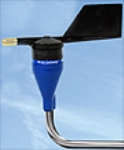May 31 2010
Second Wind, a wind measurement technology firm, has recently announced a backup source of energy for powering its Triton brand of Sonic Wind Profilers under situations when sunlight during cloudy weather is not adequate to drive the in-built solar panels.
This backup source was co-developed by the company with Sirus Integrator, its partner for alternative energy solutions. It is based on a cost-effective dependable version of fuel cells that are powered by methanol. This backup unit has been integrated with the Triton primary energy system that has solar panel rechargeable onboard batteries for meeting its low power requirements. The backup unit provides the power to Triton automatically during extended periods of low sunlight.
 Second Wind wind vane
Second Wind wind vane
Triton wind profilers can be installed in remote regions and can function for more than 60 days without or little solar charging. This backup energy source helps Triton in gathering wind data continuously without interruption.
Triton is used by wind energy companies for the operation of wind farms and suggested locations of wind farms. It offers advanced wind-related information at the site to wind farm owners and developers. This information is used for streamlining project development, financing and operations. Triton can be remotely monitored by users in near real-time basis by using the Web-accessible SkyServe network of Second Wind. The Triton units are portable and can be deployed in off-electrical grid, remote regions that include extreme southern and northern latitudes having cloudy days and short day light days for more than 12 months.
Sirius Integrator’s President John Merlino informs that Sirius focuses on offering highly dependable green power for remote-based instrumentation applications like Triton. He explained that the Triton system of Second wind is an ideal utilization of a low power type of direct methanol fuel cell.
Second Wind's Chief Technology Officer and one of its founders Walter Sass informed that every wind site decision involves lot of expenses and poor siting can result in a cost of 10% of its annual output for a wind turbine unit.